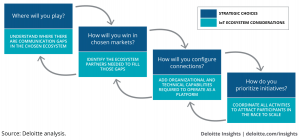IoT and 5G growing together: Partnerships drive innovative IoT of the future
As IoT becomes an established part of everything from advanced manufacturing to home security, it is easy to forget that it’s not done evolving. New use cases are coming online every day to solve some of the most difficult problems facing companies and people. IoT systems in remote medicine, augmented reality and drone delivery are tantalizingly around the corner. All that these systems need to take off is widespread, low-latency connectivity to devices spread out throughout the world.
That is exactly what 5G wireless aims to bring. 5G is a set of protocols and new technologies that link different wireless communications networks together into a “network of networks” capable of greater speed, bandwidth and lower latency than ever before. Those new capabilities, in turn, allow IoT to take on new challenges that were previously too difficult or too costly. For example, the increased bandwidth of 5G can allow firefighters and ambulance crews to make use of augmented reality, pulling up data about the model of a car involved in a crash or care procedures for a patient with a rare condition. Similarly, the low latency of 5G networks can allow doctors to perform delicate surgeries remotely, bringing advanced medical care to isolated communities for the first time.
New opportunities, but also new confusion
While 5G can allow IoT to do more than ever before, it also presents some unique business challenges both to communication providers and IoT users. Previously, communications could be a neatly circumscribed layer to any technology. With 5G, that becomes more complicated. As Dr. Usman Javaid, head of digital products and solutions at Vodafone, described it, “While it was clear in 4G, in 5G the boundaries between what is infrastructure and what is an application is less clear.” For example, getting the low latency necessary to conduct remote surgeries not only requires new infrastructure from wireless carriers, but application developers must handle data in certain ways as well, otherwise the application could end up slowing down the fast communications from the larger network. The flexible software-defined nature of 5G makes this sort of integration possible, but it also demands wireless carriers and solution developers work together in unprecedented ways to make an IoT system work.
Approach IoT on a use-case by use-case basis
Every new IoT technology will likely have slightly different communication needs. Some will need high bandwidth, others long battery life and still others ultra-low latency. Since these communication needs drive how wireless carriers and solution developers should work together, the relationships between carriers and developers will be driven by each particular use case. Carriers “need to think about the use cases that 5G enables and find the players involved in those ecosystems to make it happen. Carriers have an opportunity to be a part of the service solution,” Javaid said.
That level of cooperation can be a big change in approach for both carriers and IoT users who are used to a more typical seller-buyer relationship. However, adapting to a new approach is crucial for the long-term success of carriers in a 5G-for-IoT world. While there is value in pure connectivity, the real value 5G creates will be in the new IoT use cases it enables. If carriers want a slice of that value, they need to be involved in the IoT solution development.
That means that future IoT use cases will increasingly be the product of ecosystems and not just lone tech wolves tackling problems. As Pim Den Uyl, VP of business development at Ericsson, said, “No one can do all of this themselves, so what role do you play and who do you work with?”
The start of many beautiful relationships
So how should wireless carriers and IoT solution developers approach these new relationships? Den Uyl provided some key insights:
- From an operator perspective, the first challenge is to understand the different industries — what are their pain points and what value can you create? Then consider with which industry you want to prioritize working.
- The second challenge — for all players — is how does the ecosystem evolve and what is your role? With whom do you partner?
 While this use-case driven approach to partnerships may feel unusual, it is not wholly new. Deloitte’s research into IoT ecosystems has uncovered a few considerations that can help turn a traditional strategic planning process into one that cultivates the right ecosystem of partners:
While this use-case driven approach to partnerships may feel unusual, it is not wholly new. Deloitte’s research into IoT ecosystems has uncovered a few considerations that can help turn a traditional strategic planning process into one that cultivates the right ecosystem of partners:
- Understand where there are gaps in the ecosystem. In any industry, there can be gaps and imperfect connections between participants. Identifying where the gaps currently exist in a market or where customer needs are not being fully satisfied can help uncover the use cases where a company should focus.
- Identify the ecosystem partners needed to fill those gaps. Once a use case within an ecosystem is identified, companies should begin to assess what is needed to close that gap. In IoT, rarely is any single company able to provide all of the technology and expertise necessary to make any system work. Therefore, identifying the right mix of carriers, technology providers, developers, integrators, customers and others can be a critical first step toward platform development.
- Add capabilities to fill that gap. With an initial set of partners in place, a potential platform provider can begin to assess what organizational and technological capabilities it needs to make the new IoT system work. Considering the relative strengths of each partner is key to understanding what role each should play.
- Attract participants in the race to scale. As a new system begins to bear fruit, understanding how different partners capture value from it is key to scaling and long-term success. If only one partner benefits from a new technology, it is unlikely to last very long.
5G communications are set to take IoT to new heights, enabling heretofore undreamt of applications and use cases. But with entirely new technologies comes a new way of doing business — one built on partnerships and shared expertise. While that may seem new and uncomfortable, a few easy considerations can help any company — whether wireless carrier or IoT solution developer — grow into the new world of 5G and IoT.
All IoT Agenda network contributors are responsible for the content and accuracy of their posts. Opinions are of the writers and do not necessarily convey the thoughts of IoT Agenda.
